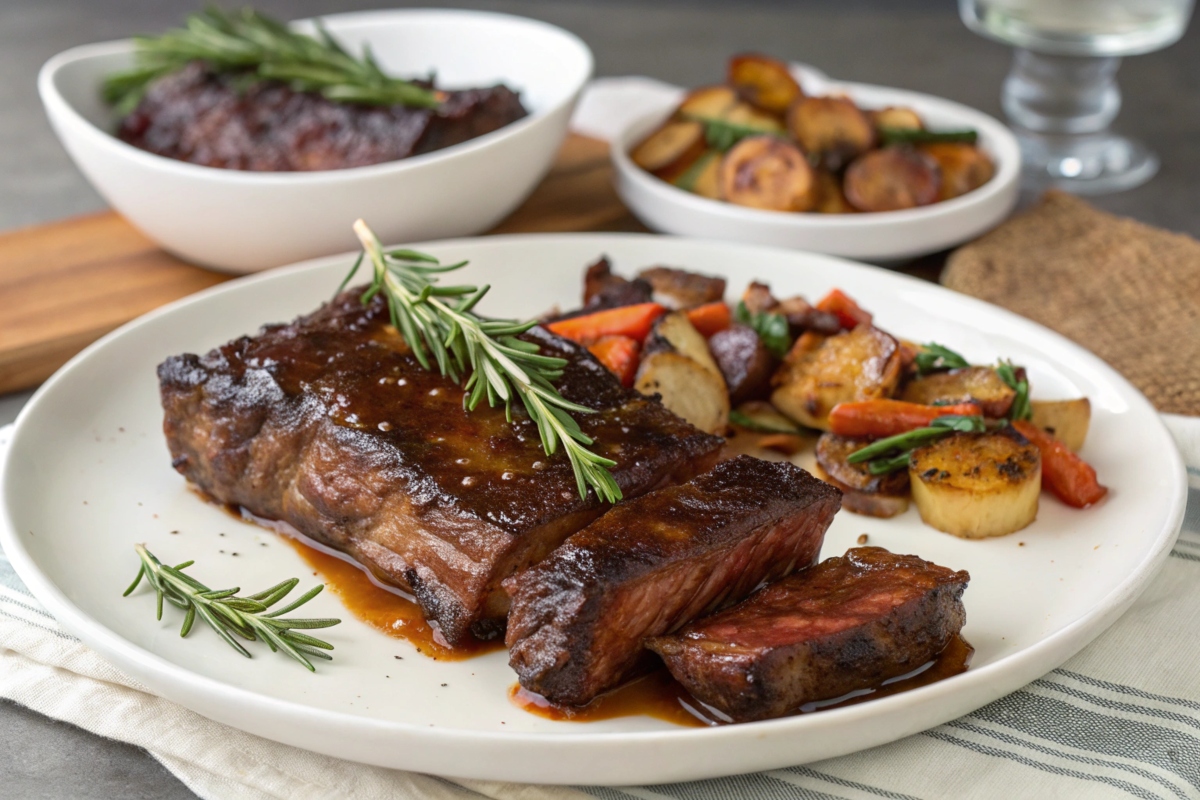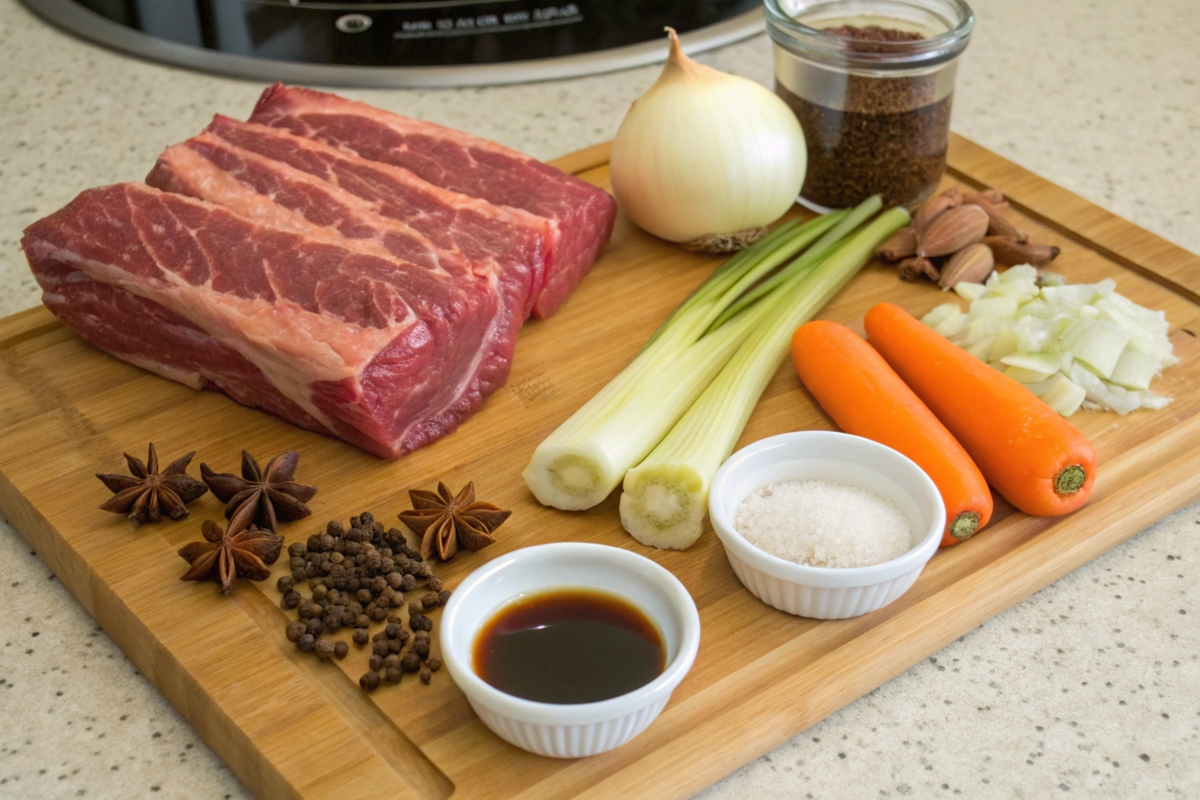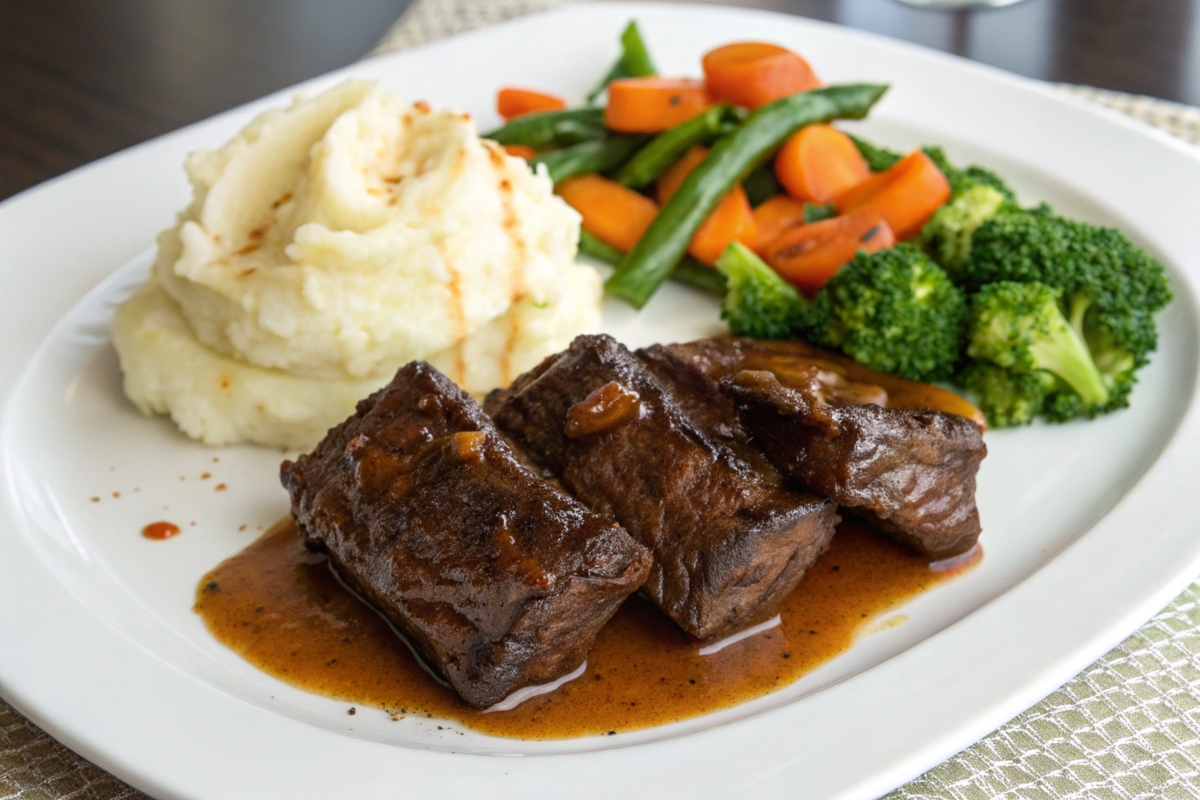Craving a hearty and flavorful meal that’s easy to make and guaranteed to impress? This boneless beef short ribs recipe is the answer to your culinary dreams! Packed with tender, melt-in-your-mouth beef and infused with rich, savory flavors, this recipe is perfect for family dinners, special occasions, or just treating yourself to a comforting dish. From selecting the best cuts to mastering cooking techniques, we’ll guide you through every step of the process. Let’s dive into creating a dish that will have everyone coming back for seconds!
What Are Boneless Beef Short Ribs?
Understanding Boneless Beef Short Ribs
This boneless beef short ribs recipe are a succulent cut of beef known for their rich marbling and deep, beefy flavor. Unlike their bone-in counterparts, these ribs are cut from the chuck or plate section of the cow, making them more tender and easier to cook evenly. They’re versatile and can be prepared in countless ways, whether you’re braising, grilling, or slow-cooking.
Difference Between Boneless and Bone-In Ribs
While both cuts offer incredible taste, boneless ribs are quicker to prepare and serve since there’s no bone to contend with. Bone-in ribs, however, retain a slightly stronger flavor due to the marrow and connective tissue. Ultimately, the choice comes down to convenience versus tradition—both are fantastic!
Ideal Cuts for Short Ribs
When selecting boneless beef short ribs, look for pieces with a good amount of marbling (the thin streaks of fat within the meat). This fat renders during cooking, ensuring the ribs stay moist and flavorful. Avoid cuts that appear too lean, as they may become tough when cooked.
For more details on beef cuts, check out this Guide to Beef Cuts.
Ingredients Needed For Boneless Beef Short Ribs
Gathering Your Ingredients
Alright, let’s dive in! To whip up this delectable boneless beef short ribs recipe, you’ll need to assemble some essential ingredients. Having everything ready beforehand makes the cooking process smoother than butter on a hot biscuit.
Key Ingredients Explained
- Boneless Beef Short Ribs: About 2 pounds of tender beef with good marbling for that melt-in-your-mouth experience.
- Olive Oil: For searing the ribs and adding a subtle richness.
- Garlic Cloves: 4 cloves, minced; because who doesn’t love that garlicky goodness?
- Onions: 1 large onion, sliced; adds sweetness and depth.
- Beef Broth: 2 cups; forms the base of our savory sauce.
- Tomato Paste: 2 tablespoons; thickens the sauce and adds a tangy note.
- Red Wine: 1 cup (optional but highly recommended); enhances flavor complexity.
- Fresh Herbs: Sprigs of thyme and rosemary for an earthy aroma.
- Salt and Pepper: To taste; the classics never fail.
Optional Ingredients for Flavor Variations for Boneless Beef Short Ribs
- Soy Sauce: A splash for an umami boost.
- Brown Sugar: 1 tablespoon if you fancy a hint of sweetness.
- Spices: A pinch of paprika or chili flakes to spice things up.
Tip: Feel free to get creative and adjust the seasonings to suit your palate!
Step-by-Step For Boneless Beef Short Ribs
Preparing the Ribs
First things first, pat those boneless beef short ribs dry with a paper towel. This ensures a nice, crispy sear. Season them generously with salt and pepper on all sides. In a large skillet or Dutch oven, heat 2 tablespoons of olive oil over medium-high heat. Once the oil is shimmering, add the ribs in batches (don’t crowd the pan!) and sear until they develop a golden brown crust. Remove the ribs and set them aside.
Marinating Techniques
Oh boy, here’s where the magic happens! If you’ve got the time, marinating the This boneless beef short ribs recipe can take your dish from great to phenomenal. In a large zip-top bag, combine the red wine, minced garlic, and fresh herbs. Add the seared ribs, seal the bag, and let them marinate in the fridge for at least 2 hours—or overnight if you’re planning ahead. Trust me, your taste buds will thank you.
Cooking Methods For Boneless Beef Short Ribs
Oven Method
Preheat your oven to 325°F (165°C). In the same pot used for searing, sauté the sliced onions until they’re translucent. Stir in the tomato paste and cook for about a minute. Pour in the beef broth (and any leftover marinade if you marinated the ribs), scraping up those flavorful brown bits from the bottom—that’s liquid gold right there! Return the ribs to the pot, bring to a simmer, cover, and transfer to the oven. Cook for approximately 2.5 hours or until the meat is fork-tender.
Slow Cooker Method
Prefer a hands-off approach? Transfer the seared ribs and sautéed onions to your slow cooker. Add the beef broth, tomato paste, and herbs. Cook on low for 6-8 hours. The result? Braised beef ribs that are incredibly tender and flavorful.
Grill Method
Feeling the BBQ vibe? Preheat your grill to medium heat. Grill the ribs for about 5 minutes on each side to get those lovely grill marks. Then, wrap them in foil with a bit of beef broth and continue cooking on indirect heat for another 1.5 to 2 hours. This method infuses a smoky flavor that’s to die for. Check out our Beef Back Ribs
Final Touch: Glazing and Serving Boneless Beef Short Ribs
Once your boneless beef short ribs recipe are cooked to perfection, it’s time for the finishing touch. If you like a sticky glaze, brush the ribs with your favorite BBQ sauce or the reduced pan juices. Pop them under the broiler for a few minutes until they’re beautifully caramelized. Serve hot, garnished with fresh herbs or a sprinkle of sea salt.
Tips for Perfect Boneless Beef Short Ribs
Common Mistakes to Avoid
To ensure your boneless beef short ribs recipe (or any beef dish) turns out perfectly, here are some common mistakes to avoid:
- Skipping the Sear: Don’t even think about it! Searing is an essential step because it locks in those precious juices and adds depth of flavor to the meat. Without a proper sear, your dish may lack that rich, caramelized taste that makes bulgogi so irresistible.
- Overcrowding the Pan: Crowding the pan is a mistake that can lead to steaming rather than searing. Therefore, give your meat some elbow room. By cooking in batches, you ensure the beef has enough space to brown evenly, which is key for developing a perfect texture.
- Impatience: Good things come to those who wait. If you rush the cooking time, the meat will turn out tough and dry. On the other hand, taking the time to cook it properly ensures a tender, juicy result.
Secrets to a Perfect Braise
For those looking to take their beef dishes to the next level, here are some key secrets to perfecting a braise:
- Layer Your Flavors: Every step counts. From searing the meat to sautéing aromatics like garlic, onions, and herbs, each action builds complexity. By layering the flavors early on, you create a dish that’s rich and deeply satisfying.
- Low and Slow: Cooking at a low temperature over a longer period is crucial for tender beef ribs. This method allows the connective tissues to break down, resulting in melt-in-your-mouth, tender meat.
- Deglaze Properly: After searing your meat, don’t forget to deglaze the pan. Using wine or broth, scrape up those browned bits stuck to the bottom of the pan—that’s where the flavor lives! In this way, you ensure that all those flavorful residues are incorporated into the sauce, enriching the dish even more.
By avoiding common mistakes and applying these secrets, you’ll be well on your way to creating a perfectly braised, flavor-packed beef dish every time.
Nutritional Information For Boneless Beef Short Ribs
Calories and Macronutrients
For those keeping an eye on their intake, here’s the lowdown per serving (approx. 6 oz of ground beef bulgogi):
- Calories: ~450 kcal
- Protein: 30 grams
- Fat: 35 grams
- Carbohydrates: 5 grams
Health Benefits of Ground Beef Bulgogi
These servings ofBoneless Beef Short Ribs aren’t just tasty; they’re also packed with essential nutrients. Specifically, ground beef is a great source of several key nutrients:
- Protein: Ground beef bulgogi is rich in protein, which is essential for muscle building and repair. As a result, it helps support your body’s recovery after exercise and contributes to overall muscle health.
- Iron: Beef is a natural source of heme iron, which is vital for oxygen transport in the body. Thus, including beef in your diet can help maintain healthy red blood cells and prevent iron deficiency.
- B Vitamins: Ground beef is also a good source of B vitamins, particularly B12, which plays a crucial role in energy metabolism. Therefore, consuming bulgogi can help boost energy levels and improve overall vitality.
For more insights, you can check out detailed nutritional information for beef to explore its full range of health benefits and how it fits into a balanced diet.
Serving Suggestions
Sides to Pair with Ground Beef Bulgogi
When it comes to pairing sides with ground beef bulgogi recipe , there are plenty of options that enhance the flavors and create a balanced meal. For instance, consider these classic accompaniments:
- Creamy Mashed Potatoes: A classic combo that works perfectly with bulgogi. Not only do the mashed potatoes provide a smooth, comforting base, but they also absorb the rich marinade, enhancing the overall flavor of the dish.
- Steamed Asparagus: This side adds a touch of elegance to your meal. Additionally, the crisp texture and subtle bitterness of asparagus complement the savory, sweet flavors of the bulgogi, providing a nice contrast.
- Buttered Noodles: These noodles are perfect for soaking up that delicious bulgogi sauce. Moreover, the rich, buttery flavor of the noodles balances the bold, savory taste of the beef, creating a satisfying and cohesive meal.
- Roasted Vegetables: For a hearty, wholesome addition, roasted vegetables like carrots, sweet potatoes, or Brussels sprouts are an excellent choice. Their natural sweetness and slight caramelization offer a delightful contrast to the savory bulgogi.
Presentation Ideas for Boneless Beef Short Ribs
They say we eat with our eyes first, so why not make it a feast for both the taste buds and the eyes? To create a truly stunning presentation, consider serving the short ribs over a bed of mashed potatoes, allowing the creamy texture to balance the richness of the meat. Next, drizzle the ribs with the rich, savory pan sauce, making sure to cover the meat generously. For a finishing touch, garnish with a sprig of rosemary or a sprinkle of fresh parsley. This simple yet elegant presentation will make your guests feel like they’ve stepped into a gourmet restaurant, and it’s sure to impress at any dinner table. Elevate your dish by pairing it with: Steak and Potatoes Recipe
Storage and Reheating Instructions
Proper Storage for Leftovers
Got leftovers? Lucky you! To ensure that your ground beef bulgogi stays fresh and flavorful, follow these storage tips:
First, allow the bulgogi to cool completely at room temperature. This step is important because storing hot food can cause condensation inside the container, which may make the dish soggy and affect its texture. Once cooled, transfer the bulgogi to an airtight container to lock in the flavor and prevent it from absorbing odors from other foods in the fridge.
Next, store the container in the refrigerator, where it will keep for up to 3 days. However, if you don’t plan to eat the leftovers within this time frame, you can also freeze the bulgogi for longer storage. To do so, place the cooled dish in a freezer-safe container or resealable bag, ensuring it is tightly sealed to prevent freezer burn. In the freezer, it will last up to 2-3 months, allowing you to enjoy bulgogi at a later time.
When you’re ready to reheat the leftovers, you can warm them up in a pan over medium heat or in the microwave. If reheating in a pan, a splash of water or broth can help restore moisture and prevent the bulgogi from drying out. This method will help retain its delicious flavor and texture.
By following these simple steps, you can make the most of your bulgogi leftovers, enjoying the dish at its best even after a few days.
Reheating Tips Without Losing Flavor
To reheat without drying them out Storing and Reheating Leftovers Safely, place the ribs in a baking dish with a bit of leftover sauce or broth. Cover with foil and warm in a preheated oven at 300°F (150°C) for about 20 minutes. They’ll be just as juicy and flavorful as the first time around.
Conclusion
In conclusion, this boneless beef short ribs recipe offers a perfect balance of rich flavors, tender texture, and easy-to-follow steps that make it a standout dish for any occasion. Whether you’re preparing it for a family dinner, a special celebration, or simply indulging in a comforting meal, the result will always be the same: a satisfying, delicious experience that leaves everyone asking for more. By following the tips for selecting the best cuts, mastering cooking techniques, and pairing with delicious sides, you’re sure to impress your guests and create a memorable meal every time. So, gather your ingredients, get cooking, and enjoy the irresistible flavors of this hearty dish!
FAQs
What is the preferred cooking method for boneless short ribs?
The best cooking method for boneless short ribs is, without a doubt, low and slow cooking. For example, braising in the oven or slow-cooking in a crockpot works wonders to break down the tough connective tissues, resulting in tender and flavorful meat. Additionally, grilling is another great option if you’re craving a smoky flavor. However, it’s important to pre-braise the ribs before grilling to prevent them from becoming tough and chewy.
Are boneless beef ribs the same as short ribs?
Not exactly. While boneless beef ribs and short ribs share certain similarities, they are not identical. Specifically, boneless beef ribs are often cut from the chuck or plate sections, making them essentially short ribs without the bone. On the other hand, traditional short ribs are sold with the bone attached, which can enhance the flavor as they cook. Therefore, if you’re looking for convenience, boneless short ribs are a better option, but bone-in ribs offer a more robust taste.
Does short rib get more tender the longer it cooks?
Yes, short ribs become more tender the longer they cook, provided they are cooked at a low temperature. For instance, slow cooking allows the connective tissues and collagen to break down gradually, which creates a melt-in-your-mouth texture. However, if you cook them too long or at excessively high temperatures, they may become dry instead of tender. Thus, it’s essential to monitor the cooking process closely to achieve the best results.
Why are my boneless short ribs tough?
Tough boneless short ribs can often be attributed to either insufficient cooking time or high cooking temperatures. Since these ribs need time to break down their connective tissue, they should always be cooked slowly at low temperatures. Furthermore, make sure they are submerged in enough liquid if you are braising them, as this helps maintain moisture. For instance, searing the ribs before slow cooking locks in both moisture and flavor, ensuring they turn out tender every time. If your ribs are still tough, simply extend the cooking time to allow the tissues to break down fully.




1 thought on “Perfect Boneless Beef Short Ribs Recipe: Easy & Flavorful Guide”